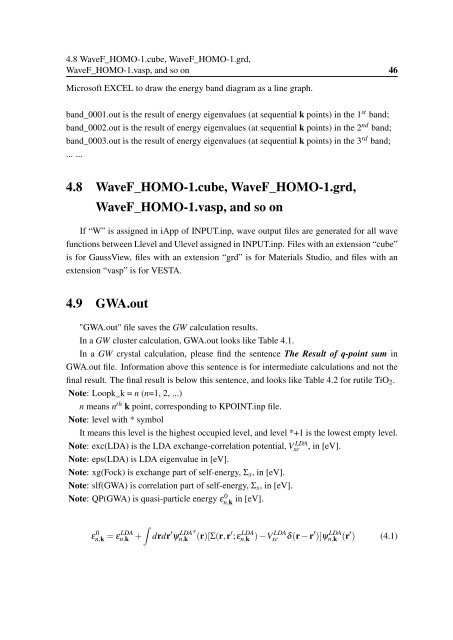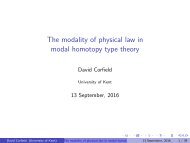TOMBO Ver.2 Manual
TOMBO
TOMBO
Create successful ePaper yourself
Turn your PDF publications into a flip-book with our unique Google optimized e-Paper software.
4.8 WaveF_HOMO-1.cube, WaveF_HOMO-1.grd,<br />
WaveF_HOMO-1.vasp, and so on 46<br />
Microsoft EXCEL to draw the energy band diagram as a line graph.<br />
band_0001.out is the result of energy eigenvalues (at sequential k points) in the 1 st band;<br />
band_0002.out is the result of energy eigenvalues (at sequential k points) in the 2 nd band;<br />
band_0003.out is the result of energy eigenvalues (at sequential k points) in the 3 rd band;<br />
... ...<br />
4.8 WaveF_HOMO-1.cube, WaveF_HOMO-1.grd,<br />
WaveF_HOMO-1.vasp, and so on<br />
If “W” is assigned in iApp of INPUT.inp, wave output files are generated for all wave<br />
functions between Llevel and Ulevel assigned in INPUT.inp. Files with an extension “cube”<br />
is for GaussView, files with an extension “grd” is for Materials Studio, and files with an<br />
extension “vasp” is for VESTA.<br />
4.9 GWA.out<br />
"GWA.out" file saves the GW calculation results.<br />
In a GW cluster calculation, GWA.out looks like Table 4.1.<br />
In a GW crystal calculation, please find the sentence The Result of q-point sum in<br />
GWA.out file. Information above this sentence is for intermediate calculations and not the<br />
final result. The final result is below this sentence, and looks like Table 4.2 for rutile TiO 2 .<br />
Note: Loopk_k = n (n=1, 2, ...)<br />
n means n th k point, corresponding to KPOINT.inp file.<br />
Note: level with * symbol<br />
It means this level is the highest occupied level, and level *+1 is the lowest empty level.<br />
Note: exc(LDA) is the LDA exchange-correlation potential, Vxc<br />
LDA , in [eV].<br />
Note: eps(LDA) is LDA eigenvalue in [eV].<br />
Note: xg(Fock) is exchange part of self-energy, Σ x , in [eV].<br />
Note: slf(GWA) is correlation part of self-energy, Σ x , in [eV].<br />
Note: QP(GWA) is quasi-particle energy εn,k 0 in [eV].<br />
∫<br />
εn,k 0 = εLDA n,k +<br />
drdr ′ ψ LDA<br />
n,k<br />
∗<br />
(r)[Σ(r,r ′ ;ε LDA<br />
n,k<br />
LDA<br />
) −Vxc<br />
δ(r − r ′ )]ψn,k LDA (r′ ) (4.1)



